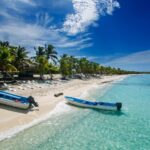
Discovered in 1494, Catalina Island hides history and secrets of pirates and corsairs
Catalina Island was discovered in 1494 by the navigator Christopher Columbus on his second voyage to the American continent and was named in honor of the daughter of Queen Isabella of Castile, but it is also known as Ikiita Island and is called by the indigenous people places like Labanea or Toeya. It is part of the trio of adjacent islands in the southeast of the Dominican Republic, along with La Saona and La Catalinita, with La Saona being the only inhabited one.
Catalina Island was, like other areas of the Caribbean, a refuge for pirates and corsairs from 1520 to the 1720s. They awaited the Spanish ships that passed by to attack and rob them, which is interesting for lovers of these ancient stories.
One of these stories is that of William Kidd, better known as Captain Kidd, a British sailor who was executed, accused of piracy in 1701 and who is shown in English literature as one of the most famous outlaws of all time. The remains of his ship, the Quedagh Merchant, were discovered, submerged just meters from the island’s shore, by Indiana University archaeologists in 2007.
Located a few kilometers southeast of the island of Hispaniola and about 100 kilometers from Santo Domingo, Catalina Island, an uninhabited paradise but with all the necessary infrastructure for the visitor’s enjoyment, has an area of about 10 km², a warm tropical climate and humid with average temperatures of 25 degrees. It only has one area, known as VIP, where human presence can be verified.
Catalina Island can be reached half an hour by boat from La Romana, the closest point, and is occasionally a destination for cruise ships that have routes in the Caribbean and that can take their passengers to private beach spaces. It does not have large dimensions but it is the second largest in the Dominican Republic, after Isla Saona.
dominican-republic_catalina-island
Catalina Island
To enjoy Catalina Island, excursions can be made from Punta Cana, Santo Domingo or from the port of La Romana and some of the services may include tasting Caribbean dishes, tropical drinks or even taking merengue and bachata classes. The average time to visit the island is ten hours, but with all certainty, the visitor will not want to leave it.
Catalina Island has three main beaches, the North, the East and the West and although the latter is the one with the greatest development and the one that receives the greatest influx of tourists, the great potential that the others have for the delight of visitors.
What to do in Catalina Island?
Santa Catalina is a jewel in the Dominican Republic and one of the best places to take a relaxing bath. Its waters, with large banks of coral, house the Living Museum of the Sea in addition to the discovery of the shipwreck of Captain Kidd at a depth of 21 meters, in the adjoining area.
The entire Catalina Island is ready to take the visitor to daydreams with various snorkeling and diving tours that delight the eye with colorful fish and live corals but also, divers can have a magical, unique experience in the Catalina Wall, a imposing wall, which falls to more than one hundred meters deep allowing you to enjoy coral gardens and tropical and wildlife, an incomparable underwater ecosystem.
Diving lovers find another wonder in the Aquarium, with a depth of eleven meters and huge carpets of live coral formations, coexisting with the endemic species of the site, the lion fish and toad among many others.
For those who do not want to leave the ship, Catalina Island is a visual spectacle of colors and landscapes among the rock formations, such as Morgan’s Head, a huge stone that looks like a human profile, the beaches of fine sand and the vegetation.
Fishing lovers also find in this paradise in the Dominican Republic the possibility of emotion and relaxation that this sport produces and more traditional visitors can dream in the sand with the feeling of fine powder after taking a relaxing bath.
Catalina Island, a garden of Eden with incomparable flora and fauna
catherine island
Catalina Island
On Catalina Island, dreamy landscapes with beaches of fine white sand and calm, warm waters are the home, the home, of a great diversity of flora and fauna, also cared for because this island is an Ecological Reserve and is part of the protected National Park of the East. , in whose space live more than 500 species of flowers and 300 of birds.
The terrestrial fauna of Catalina Island is mainly endemic and includes one species of frog, one tortoise, two snakes, six lizards, ten birds, four sea turtles, and a few mammals.
If we talk about fish, a multicolored prism of varieties awaits the visitor: seahorses, sponges, puffer fish with beautiful shades, butterfly fish swimming in pairs, queen angelfish, horned boxfish, sea urchins, trumpet fish, yellow mullet , the painted chapín and another great variety of them that also enjoy the warm and crystalline waters of Catalina Island.
As for the flora, the tropical dry forest is present throughout the geography of Catalina Island and the chaparro, the resbalamano and the olive tree abound, although mango trees, coconut palms and palms, among them the pactá, endemic to the area, find here its vital place, along with mangroves and bushes. In the depths of its waters, Catalina Island is home to an idyllic garden of coral reefs.









